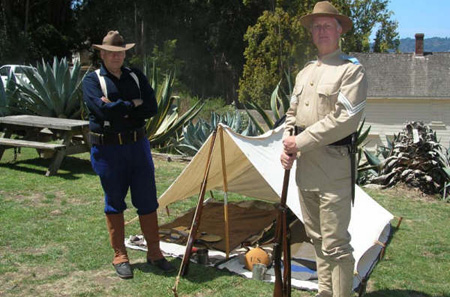Offering spectacular views of the San Francisco skyline, the Marin Headlands and Mount Tamalpais, Angel Island is the largest island in San Francisco Bay.

BC Staff Report
Published: August, 2008
Local residents usually know where Angel Island is located—one mile south of the Tiburon Peninsula—but, surprisingly, most have never visited. Maybe that’s because the visitor’s center, in Ayala Cove on the north side of the Island, is only accessible by ferries or private boats.
Angel Island is a stunning, underutilized natural resource in the Bay Area; Bay Crossings will be dedicating space in the next few issues to feature more on Angel Island and events taking place there. We urge people to jump on a ferryboat and visit this beautiful and historic island right in our own backyard. Over 13 miles of foot trails and fire roads circle the entire island. Trails lead to the 788-foot high summit of Mt. Livermore; eight miles of roadway are available for bike riding. Bicycles can be used on the island-circling Perimeter Road and the fire roads.
The island is alive with history. Three thousand years ago, it was a fishing and hunting site for Coastal Miwok Indians. It was later a haven for Spanish explorer Juan Manuel de Ayala, a cattle ranch, and a U.S. Army post. From 1910 to 1940, the island processed hundreds of thousands of immigrants, the majority from China. During World War II, Japanese and German POWs were held on the island, which was also used as a jumping-off point for American soldiers returning from the Pacific. In the ‘50s and ‘60s, the island was home to a Project Nike missile base. Finally, it became a State Park in 1954.
Angel Island is open from 8 a.m. to sunset all year and is accessible by ferries leaving from San Francisco, Tiburon, Alameda and Vallejo via transfer in SF. (See ferry schedules on page 19.) Private boats can use the boat slips or the 27 new mooring buoys at Ayala Cove. Slips, 30’ to 50’, cost $10. The California State Park Annual Day Use Pass, costing $125, can be used to pay dock fees. Mooring fees are $20 per night and can be used up to seven nights in a row. Slips and buoys are on a first-come first-served basis.
Victorian Days is a free living-history program on Angel Island. On August 16 and 17, from 10:30 a.m. to 3:00 p.m. each day, volunteer re-enactors will bring to life the soldiers who were stationed at Camp Reynolds from 1863 through 1940.
Camp Reynolds, Angel Island, was established to support coast artillery covering the entrance to the San Francisco Bay in 1864, and was an active U.S. Army post until the end of WWII. Camp Reynolds includes a brick quartermaster building, now used as a living history barracks, and original officers’ quarters, dating from 1864 to the 1880s. One is fully restored and furnished in circa-1880 Indian Wars furnishings and artifacts.

Dave Nelson on left and Steven Gay are volunteers at Victorian Days. Photo courtesy of Angel Island State Park

